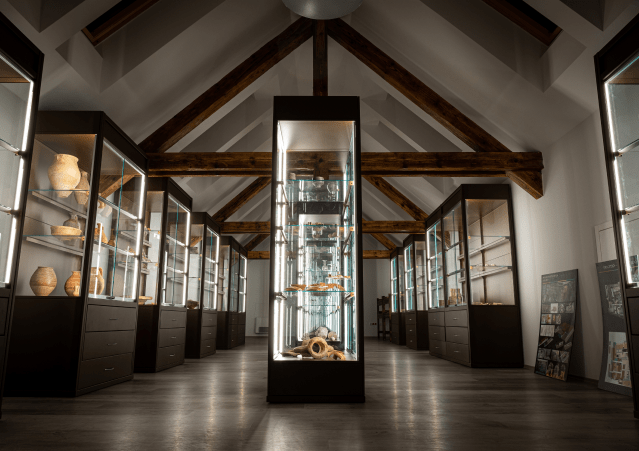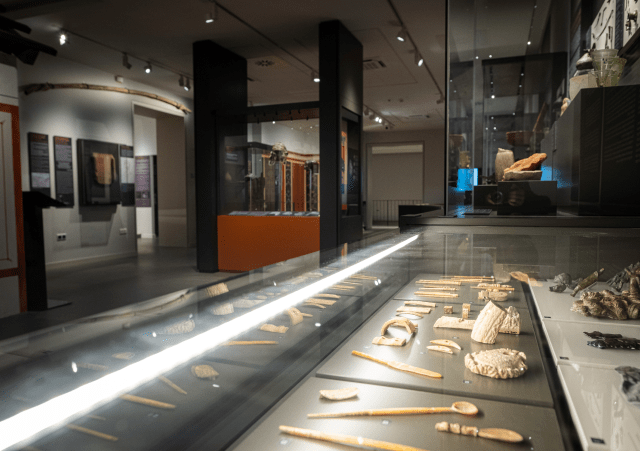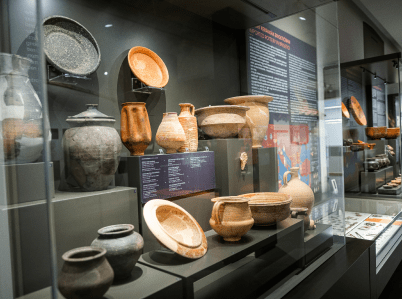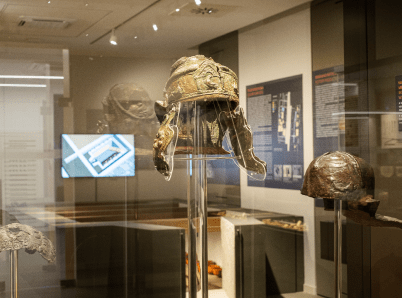Permanent exhibitions
Brigetio Heritage Archaeological exhibition
For more than 300 years from the beginning of the 2nd century AD, the army stationed in Brigetio, built on the flood-free terraces in the area of today’s Komárom-Szőny, together with the military personnel of the watchtowers and the Roman garrison of Kelemantia, on the other bank of the Danube at Izsa-Leányvár, protected the northern border of the Roman province of Pannonia, the so-called ripa Pannonica.
Its territory was the scene of imperial events, as evidenced by the archaeological finds here. Nearly 40 smarching camps, which can be observed in aerial photographs, are related to the Marcomannic Wars of Marcus Aurelius (167-180), and it was in the representative building excavated in the legionary fortress that Valentinian I died on 17th November 375, and his son was proclaimed emperor.
The main parts of the complex were the legio camp, the soldiers’ town and the citizen town.
The 540 x 430 m floor area legionary fortress was built by legio XI Claudia and later by legio I Adiutrix under the emperor Trajan (97-118). This latter military unit of dome 5500 soldiers stayed in Brigetio until the province was abandoned in the 430s AD. Archaeological excavations and geophysical researches have identified several important parts of the legionary fortress: the northern gate (porta praetoria) and the centre (principia), the military hospital (valetudinarium), the baths (thermae), the granary buildings (horrea), and a large part of the street system.
In the canabae, a military town with no official Roman town’s rank, lived the legionaries’ families, the supply staff, craftsmen, servants, priests and merchants. The area is dotted with painted houses, streets, churches, an amphitheatre and public baths, which were replaced from the 4th century onwards by late Roman cemeteries.
The civilian population lived in a municipium, which was given the rank of municipium by 205 AD at the latest. It had public buildings that met the criteria of municipia and an amphitheatre. It was supplied by various workshops.
Brigetio was a truly thriving multicultural provincial town of 15-20 thousand inhabitants, where people came from all corners of the Empire, either as soldiers or as traders on the Limes Road that passed through.
Modern archaeological excavations have been carried out in Brigetio since 1992, in cooperation with the Klapka György Museum of Komárom and Eötvös Loránd University. The excavations, financed by the Municipality of Komárom and supported by the National Cultural Fund, are led by László Borhy, Rector of ELTE, Dávid Bartus, Dean of ELTE and Emese Számadó, Director of the museum, while other archaeological tasks are carried out by Gabriella Gátfalvi-Delbó, archaeologist of the museum.




Excavations were carried out on the site of Komárom/Szőny-Vásártér, at the area of citizen town for 25 years until 2016, and the results of these excavations outlined the structure of the town, the layout of the buildings and the everyday life of its inhabitants.
We worked under the project of “Improving the flood protection safety of the Komárom – Almásfüzitő flood protection bay” from 2014 to 2017, at Komárom/Szőny-Dunapart site location, on the northern side of the former Limes Road. We excavated an area of almost 1 ha in the region of the military town of Brigetio, where we found Iron Age objects (houses, tombs, stoves, ovens) and large Roman public buildings. On the western side of the site is a bath, which preserved large areas of terrazzo floors, underfloor heating systems, and numerous canals and road surfaces. The building has a floor area of about 900 m2 and is almost regular square in shape. A large number of fragments of wall paintings have been recovered from the bath, most of them depicting Victorias holding shields. In the eastern part of the site, two large storage buildings with economic function, known as horreum, were excavated.
We started excavations at the Brigetio legionary fortress in 2015. In recent years, we have worked in the central part of the fortress, in the principia, excavating the northern single-arched gate of the camp, and uncovering a 600 m2 Apse building with massive stone walls and a representative function built in the early 370s. It is believed to be the building where Emperor Valentinian I received the quad envoys on 17th November 375, when he suffered a stroke and died on the spot.
We are working on the excavation of the military bathing area of around 6000 m2 from 2021.
The excavation has revealed well-preserved, very solid walls, red limestone floors, complete underfloor heating systems, hot- and cold-water pools and canals. The stamped bricks of Legio XI Claudia also allowed us to determine the construction of the bath, which coincided with the earliest construction period of the camp, in which this legio participated in the period 101-105 AD.
The permanent archaeological exhibition in the Brigetio Heritage Visitor Center presents the results of planned excavations and other archaeological work carried out over the past year.
The first room displays a selection of artefacts from the excavations, based on a concept developed by Emese Számadó and Gabriella Gátfalvi-Delbó.
The military helmet, whose relief decorations are interpreted with the help of drawings by Julianna Burucs, is of unparalleled beauty.
Our unique artefact is the roof tile, which has been engraved with the portrait and name of the famous ancient poet Publius Ovidius Naso. It is currently the only known depiction of Ovidius from antiquity, all the others being from the Renaissance and later periods. The significance of the find is revealed through the drawings and reflections of the painter Frigyes Kőnig.
Here we keep the bronze law tablet of the emperor Philip the Arab, the only surviving copy of a piece of legislation of imperial importance. It is the second Roman law tablet to be found in Brigetio.
The structure of the town and the layout of the individual buildings are illustrated by Linda Dobosi’s 3D reconstructions in the room.
The interiors of the buildings can be imagined from the reconstructions of the bakery, the room and the cellar, while a virtual city walk developed by Leopoly Ltd. will show how everyday life in Brigetio was lived.




Undoubtedly, the most spectacular and famous artefacts are located in the second room. Wall and ceiling paintings depicting mythological figures (e.g., Andromeda, Perseus, Pegasus), goddesses (Luna, Fortuna) and the feast scene decorated the citizen town’s residential buildings. The paintings, restored by Eszter Harsányi and Zsófia Kurovszky and presented under a partially walkable glass sheet, offer all visitors a fascinating insight into the world of Roman interior design.
The third room takes us into the mysterious world of an ancient shrine. It houses the magnificent artefacts excavated in Brigetio, from the temple of the Syrian war god Jupiter Dolichenus, by the inspiration of archaeologists Dávid Bartus and Ádám Szabó. The objects are originally preserved in the Hungarian National Museum.
The last room, the corridor leading out of the exhibition, reveals the world of ancient cemeteries, which already in the antiquity were located along the roads leading out of the cities. The tombs including skeletons and rich grave goods tell the story of the burial customs of a bygone age. One can imagine ancient people based on the head reconstructions on display.



The information in the exhibition is complemented by photographs, reconstructions, texts and films displayed on monitors in each room, as well as a QR code multi-platform multimedia guide developed by the Institute for Computer Science and Automation.
If you fancy a bit of brain teasing, you can test your skills with games installed on the touch screens.
The creators of the permanent exhibition, archaeologists and restorers, have set themselves the goal of presenting the heritage of the Roman Brigetio in a spectacular and visitor-friendly way, using the results of the 30 years of excavations in Brigetio, supported by the Municipality of Komárom.
Open
Tuesday – Sunday: from 9 am to 5 pm
On public holidays: from 9 am to 5 pm
Ticket
Free entry
Contact
Email: brigetio@brigetio.hu
